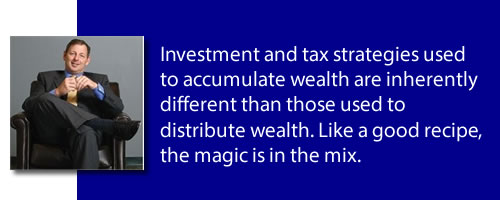Everyone has different levels of knowledge when it comes to their finances. Many people don’t know the basics, such as how compounding interest works, while others are challenged by the differences between stocks and bonds. Even people who have accumulated wealth throughout their lifetime can have gaps in their financial knowledge.
One key gap in financial knowledge is what happens when someone retires. While there might be comfort with investing and accumulating wealth, many people don’t know what to do with respect to distributing that wealth so that it lasts through retirement. Failure to properly manage one’s portfolio can lead to serious tax implications or even running out of money sooner than expected.
“Many clients don’t understand that accumulation and distribution of wealth are significantly different,” said Anthony Bartlett, founder and CEO of Bartlett Wealth Management LLC. “The magic is in the mix. You only have one shot at retirement. While many clients have a great deal of experience in accumulating their wealth, they don’t have the knowledge to handle the distribution side of their wealth.”
Teaching has always been a significant part of Bartlett’s life and career, as both his parents were educators. He learned how to converse with students, and applied these lessons to explaining industry jargon, converting it into real words that his clients could understand. From discussing retirement planning to long-term care insurance and other service offerings, Bartlett knows how to break down complicated terms into everyday language, as well as clearly explain investment and retirement strategies to make clients more comfortable. Explaining complicated subjects using “simple” methodologies can help clients better understand, and remain consistent with, retirement fund distribution strategies. For example, Bartlett – who has earned several professional designations including that of Chartered Financial Consultant (ChFC) and Retirement Income Certified Professional(RICP) - uses the “bucket” approach to help clients segment their retirement funds based on needs over specific time segments. Funds that are needed immediately, or within the next five years, are placed in a more conservative bucket, such as a money market fund. Funds that are needed five and ten years from now are assigned to buckets with higher risk/return exposure.
Explaining complicated subjects using “simple” methodologies can help clients better understand, and remain consistent with, retirement fund distribution strategies. For example, Bartlett – who has earned several professional designations including that of Chartered Financial Consultant (ChFC) and Retirement Income Certified Professional(RICP) - uses the “bucket” approach to help clients segment their retirement funds based on needs over specific time segments. Funds that are needed immediately, or within the next five years, are placed in a more conservative bucket, such as a money market fund. Funds that are needed five and ten years from now are assigned to buckets with higher risk/return exposure.
“The message here is that the power of the buckets is stronger than what is happening in the market,” said Bartlett. “My clients hardly ever ask how their portfolio is doing when the market is going up or down. I mostly get calls about how their individual buckets are doing. We follow the appropriate systems and financial tools to build those buckets, creating smart, evidence-based investments.”
Educating clients is essential when dealing with the concepts of sequential retirement and long-term care planning. It should include a discussion of what clients expect their retirement to look like, and a frank explanation of the associated costs. Age, health, geographic location and many other factors will influence retirement expenses, but current estimates state that healthcare costs will be approximately $250,000 during the retirement years. This is a key figure to build into an individual’s analysis of their retirement income.
One key topic is the impact of inflation, and how it affects both portfolio growth and spending. Bartlett explains to clients that spending often follows a “U” curve in retirement. Withdrawal rates tend to start higher at the beginning of retirement, as people will travel and spend more when first retiring. Spending then declines as people slow down, but expenses rise again as health events occur when people reach their late 70s and 80s.
“Retirement planning should include these variances in spending and expenses in the analysis process,” said Bartlett. “We must include these costs along with the impact of inflation when building a client’s portfolio. To deal with higher health care needs, we often look to insurance companies to help share the risk and build in long-term care protection.” A fiduciary has the responsibility to educate their clients on retirement options. They must also protect clients’ assets and make decisions that are in their best interest. However, the financial industry does not always clarify the difference between fiduciary and non-fiduciary advisors. Some “independent” financial advisors are not truly independent, as they are affiliated with an insurance broker-dealer, and are required to sell a certain percentage of a company’s products. That’s why it’s important for people to educate themselves when looking for an advisor, and ask how they are compensated for the products they sell.
A fiduciary has the responsibility to educate their clients on retirement options. They must also protect clients’ assets and make decisions that are in their best interest. However, the financial industry does not always clarify the difference between fiduciary and non-fiduciary advisors. Some “independent” financial advisors are not truly independent, as they are affiliated with an insurance broker-dealer, and are required to sell a certain percentage of a company’s products. That’s why it’s important for people to educate themselves when looking for an advisor, and ask how they are compensated for the products they sell.
Most people cannot comprehend a prospectus, which is understandable as these documents are often written by legal departments. While they have improved, prospectuses are still not where they should be with respect to legibility, so clients don’t read them. It’s up to the financial advisor to clearly explain in simple terms what is being sold in the prospectus, the fees and risks, and other key factors that will help clients to make educated decisions on what they are being told. It's also vital to ensure that there is no conflict of interest with the products being sold.
“It’s much like going to the doctor, as patients want to be assured that there is no conflict of interest when they prescribe tests and medications,” said Bartlett. “Transparency is important, as our clients must understand what they are paying for and what they are getting for the fees being paid.”
For more information on Bartlett Wealth Management, visit: bartlettwealth.com





